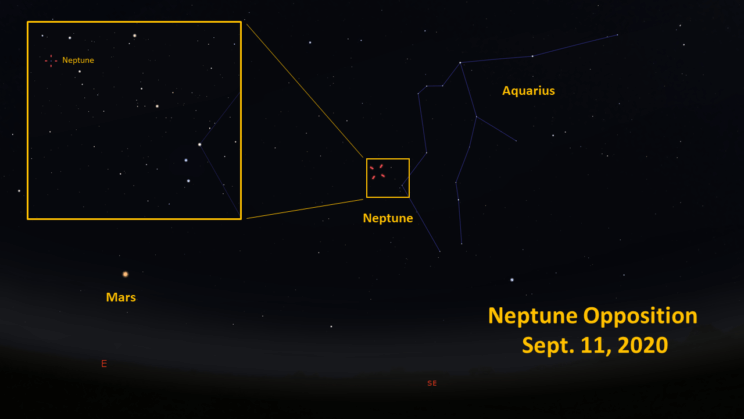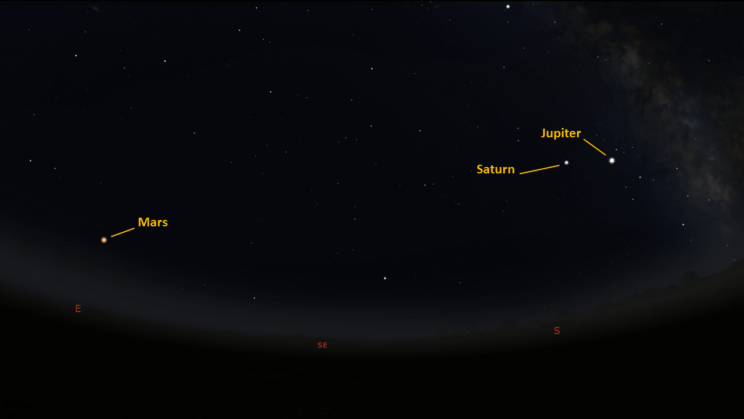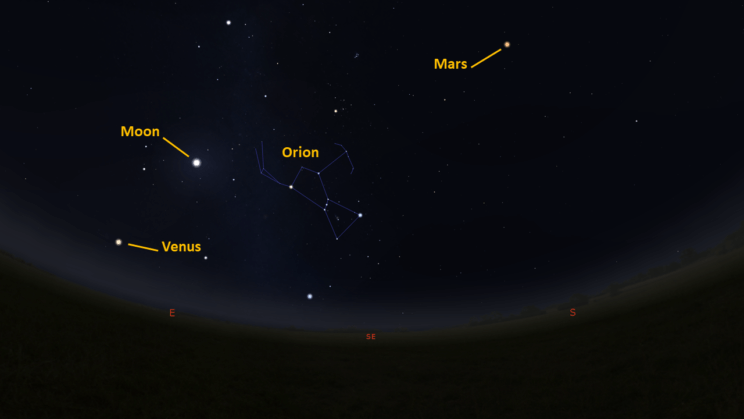This is the Saint Louis Science Center’s NIGHT SKY UPDATE for the week of Friday, September 11, 2020.
Information updated weekly or as needed.
Times given as local St. Louis time (CDT). For definitions of terminology used in the night sky update, click the highlighted text.
Public Telescope Viewings
Star parties at the Saint Louis Science Center have temporarily been canceled due to recommendations from the CDC regarding COVID-19. All public telescope events are canceled until further notice. As conditions change, we will reevaluate and update this article once public observing events resume.
Observing Highlight of the Week

Neptune Opposition September 11, 2020
Credit: Stellarium, EG
This week Neptune reaches opposition on September 11. This means Neptune will appear at its brightest for the year. Normally to see Neptune a telescope is required but during opposition Neptune reaches a magnitude of 7.8. In city lights you will still need a telescope to spot Neptune, however, in darker skies binoculars should be good enough to spot the faint planet.
It is believed Galileo was the first to spot Neptune in 1613, however, the notes detailing his observation list Neptune as a star. The official discovery of Neptune would come later in 1846 when Johann Galle using a prediction from mathematician Urbain Le Verrier spotted Neptune on September 23. With an orbital period of about 165 years, Neptune has only completed one full orbit of the Sun since its discovery.
Neptune is currently in the constellation Aquarius and rises a little after 7:00 p.m. It should clear trees and buildings by 9:00 p.m. Get to as dark a location as you can and give your eyes some time to adjust to the darkness. You will also need a decent map of the star field Neptune is located in. A great tool for this purpose is the computer program Stellarium. This is a desktop planetarium software that will make Neptune easy to find.
The Sun and Moon

The Moon as seen from the International Space Station, on July 31, 2011.
Credit: NASA
Sunrise is at 6:40 a.m. on Friday, September 11 and sunset is at 7:15 p.m. providing us with about 12.5 hours of daylight. Even after sunset, the light from the Sun will dimly illuminate our sky for about 1 hour and 30 minutes. This period is called twilight, which ends around 8:45 p.m. this week. For those with a sundial, local noon occurs around 12:57 p.m. this week.
| Day | Sunrise | Sunset |
|---|---|---|
| 2020-09-11 | 6:40 a.m. | 7:15 p.m. |
| 2020-09-12 | 6:41 a.m. | 7:13 p.m. |
| 2020-09-13 | 6:41 a.m. | 7:12 p.m. |
| 2020-09-14 | 6:42 a.m. | 7:10 p.m. |
| 2020-09-15 | 6:43 a.m. | 7:08 p.m. |
| 2020-09-16 | 6:44 a.m. | 7:07 p.m. |
| 2020-09-17 | 6:45 a.m. | 7:05 p.m. |
| 2020-09-18 | 6:46 a.m. | 7:04 p.m. |
| 2020-09-19 | 6:47 a.m. | 7:02 p.m. |
Moon
Moonrise for Friday, September 11 occurs at 12:09 a.m. and moonset will occur at 15:28 p.m. On Friday, September 11 the Moon will exhibit a waning crescent phase with about 35% of the lunar disk illuminated. New moon occurs on September 17 at 6:00 a.m.
International Space Station (ISS) Observing

Visible passes of ISS from St. Louis for the week of September 11 occur during morning and evening hours. The best passes this week occur on September 12, 13 and 16. Use the table below for information about these and other visible passes this week.
Catch ISS from St. Louis starting Friday, September 11
| Date | Starts | Max. altitude | Ends | |||||||
|---|---|---|---|---|---|---|---|---|---|---|
| Time | Alt. | Az. | Time | Alt. | Az. | Time | Alt. | Az. | ||
| 12 Sep | -0.7 | 04:04:19 | 16 | NE | 04:04:19 | 16 | NE | 04:05:38 | 10 | ENE |
| 12 Sep | -3.8 | 05:37:20 | 14 | WNW | 05:40:07 | 61 | SW | 05:43:25 | 10 | SE |
| 13 Sep | -3.6 | 04:52:42 | 69 | ENE | 04:52:42 | 69 | ENE | 04:55:49 | 10 | SE |
| 14 Sep | -2.2 | 05:41:23 | 19 | SW | 05:41:23 | 19 | SW | 05:43:47 | 10 | S |
| 15 Sep | -2.1 | 19:57:07 | 10 | S | 19:59:18 | 16 | SE | 19:59:49 | 16 | ESE |
| 16 Sep | -3.9 | 20:44:43 | 10 | SW | 20:48:05 | 86 | NW | 20:48:07 | 86 | NNW |
| 17 Sep | -3.6 | 19:57:09 | 10 | SSW | 20:00:24 | 51 | SE | 20:03:06 | 14 | ENE |
| 17 Sep | -0.8 | 21:34:42 | 10 | W | 21:36:05 | 18 | WNW | 21:36:05 | 18 | WNW |
| 18 Sep | -2 | 20:46:28 | 10 | W | 20:49:31 | 31 | NNW | 20:50:49 | 23 | N |
| 19 Sep | -2.9 | 19:58:25 | 10 | WSW | 20:01:42 | 50 | NW | 20:04:59 | 10 | NE |
Magnitude (Mag): The Measure of brightness for a celestial object. The lower the value is, the brighter the object will be.
Altitude (Alt): The angle of a celestial object measured upwards from the observer’s horizon.
Azimuth (Az): The direction of a celestial object, measured clockwise from an observer’s location with north being 0°, east being 90°, south being 180° and west being 270°.
For information about ISS flyovers and other visible satellites, visit www.heavens-above.com
Detailed information regarding all unmanned exploration of our universe, missions past, present, and planned, can be found at Jet Propulsion Laboratories:
The Visible Planets

Looking Southeast, at 10:00 pm, September 11, 2020
Credit: Stellarium, EG

Looking East, 4:00 am, September 12, 2020
Credit: Stellarium, EG
This week, four naked eye planets are visible. Jupiter and Saturn rise before sunset. Look for them in the south once it is dark. Mars rises in the evening and will be best seen after midnight. Venus can be found in the eastern sky before sunrise.
For those tracking Jupiter and Saturn as they approach their great conjunction later this year, the two gas giants currently appear about 8.2° apart in the sky. Retrograde motion is ending for both planets which means we will now see Jupiter start its journey to catch up to Saturn.
Venus
Venus is well into another morning apparition. After months of seeing Venus in the west after sunset Venus is now visible in the east before sunrise. Venus rises at 3:07 a.m. and will be easily seen by 4:00 a.m. Venus remains a morning object until March 26, 2021 when it reaches superior conjunction. Since Venus has passed greatest western elongation, it will start to exhibit a gibbous phase.
Mars
The red planet rises around 9:03 p.m. and will be high enough to see in the east by 10:00 p.m. Opposition for Mars occurs on October 13, 2020. As we head towards this date Mars will appear brighter and larger through a telescope improving surface details. Surface features are already visible when viewing conditions are favorable. Current apparent brightness of Mars is -2.1 magnitude. At this magnitude Mars will appear brighter than any star in the night sky.
Jupiter
Look for Jupiter in the southeast about 30 minutes after sunset. Jupiter will set at 1:34 a.m. Those with a telescope can enjoy views of Jupiter’s cloud features and the Great Red Spot when it is pointed towards Earth.
Saturn
Look for the ringed planet in the southeast about 30 minutes after sunset. Saturn sets at 2:14 a.m. For those with a telescope keep track of the orientation of Saturn’s rings. Since Saturn is tilted on its rotational axis, we cross the plane of Saturn’s ring every 13 to 15 years. We are headed towards another ring plane crossing on March 23, 2025. Over the next five years you will notice Saturn’s rings will gradually incline towards an edge on appearance.
2020 Great Conjunction
This year the planets Jupiter and Saturn will reach conjunction. A conjunction is when two or more celestial bodies share the same right ascension. For Jupiter and Saturn this astronomical event occurs every 20 years. The conjunction occurs on December 21, 2020. You will find the two planets close together in the southwest just after sunset on this date.
Visit the James S. McDonnell Planetarium for more information on what’s up!
Night Sky Update: September 11-September 19, 2020






